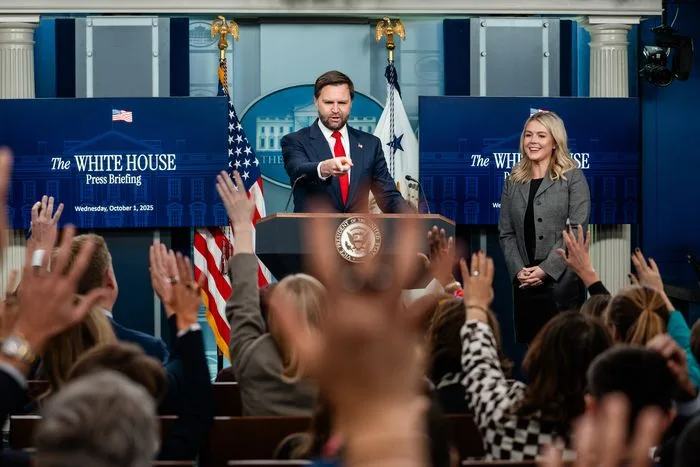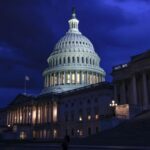By Lawrence Wilson
The federal government remains shut down after the Senate on Oct. 1 again rejected a pair of competing plans that would temporarily extend funding.
The shutdown began on Oct. 1 at 12:01 a.m. as Republicans and Democrats deadlocked over the terms of a stopgap spending agreement.
As federal employees who perform essential functions completed their first day of work without pay and others were idled, party leaders appeared unwilling to compromise.
Vice President JD Vance made a rare appearance in the White House briefing room, where he laid blame for the shutdown on Democrats, whom he said had gone “far to the left.” Senate Minority Leader Chuck Schumer (D-N.Y.) took to the Senate floor to blame the shutdown on Republicans, whom he said “can’t be bothered to protect health care.”
While party leaders remained entrenched in their positions, some rank-and-file Senators showed signs of movement toward compromise.
Here’s the latest on the 2025 government shutdown.
Both Sides Can Benefit From Standoff
Both parties have an incentive to keep the shutdown going at least for a short period, some experts told The Epoch Times. Each appears to have something to gain.
For Democrats, simply having a public fight with Republicans over health care may benefit them by rallying their base, according to Aaron Dusso, chair of political science at Indiana University–Indianapolis.
“The perception right now has been that Democrats have not done everything that they could do to try and stop the Trump administration,” he told The Epoch Times. “They need to change that perception.”
Health care is an ideal issue for Democrats to leverage, Dusso said, because it’s considered their “home turf.”
“Both sides are playing to their bases,” David Schultz, professor of political science and legal studies at Hamline University, told The Epoch Times.
He said Republicans gain by defending the ground that they won in passing the One Big Beautiful Bill Act and by holding the line on spending.
“Much of American politics now is not about mobilizing the swing voter,” Schultz said. “It’s about, ‘Can I get more of my base out to vote?’”
Layoffs Are Imminent
President Donald Trump has also played a large role in the shutdown, according to Robert Kravchuk, professor emeritus of public policy at Indiana University.
“He’s been in a hurry to get his program in place since he won the election, and he’s really not inclined to negotiate,” Kravchuk told The Epoch Times. “Everything is up for reconfiguration.”
One of Trump’s objectives has been to reduce the size of the federal government. Ahead of the shutdown, he signaled that it could be an occasion to lay off more federal workers.
“Donald Trump seems to relish the idea of at least a short-term shutdown,” Matthew Wilson, associate professor of political science at Southern Methodist University, told The Epoch Times. “It gives him a freer hand in some of his government-cutting exercises.”
During an Oct. 1 press briefing, White House press secretary Karoline Leavitt confirmed that layoffs are in the works.
“The federal government is not receiving any cash at the moment,” Leavitt told reporters.
She said the Office of Management and Budget has been tasked with determining “what can we continue to keep running and what, unfortunately, is going to have to come to an end.”
Leavitt said the layoffs would be made “very soon.”
All Eyes on Moderate Democrats
Some moderate Democrats and Republicans have shown an interest in finding a solution to the shutdown.
Sens. Catherine Cortez Masto (D-Nev.), John Fetterman (D-Pa.), and Angus King (I-Maine), who caucuses with Democrats, voted in favor of the Republican-backed continuing resolution that would reopen the government with no changes to current spending levels.
After that vote failed on Oct. 1, several senators met on the Senate floor to discuss a one-year extension of the Affordable Care Act-enhanced premium tax credits. Some Republicans had already proposed this, and the Affordable Care Act subsidies have been a key negotiating point for Democrats.
“I’m glad we’re talking,” Sen. Raphael Warnock (D-Ga.) told reporters.
Sen. Mike Rounds (R-S.D.) told reporters that “a lot of people would really like to find a path forward.”
“But it requires, first of all, to get the government open again,” he said.
The proposal under discussion would extend funding for 45 days. “And then we start working on the issues that divide us,” Rounds said.
The Affordable Care Act’s enhanced subsidies were instituted as a temporary measure during the COVID-19 era. Rounds said an extension would have to include an agreement “to get it back to pre-pandemic over the next two years.”
To meet the 60-vote threshold required to overcome a filibuster, Republicans would need five more Democrats to cross the aisle.
Shutdowns End When the Public Feels Pain
Both parties may benefit from a brief shutdown, but several experts said that will change when members of the general public begin to feel the effects.
“Once we get into a week-long shutdown or a two-week shutdown, that starts to change a bit as the consequences start to become more apparent for ordinary Americans,” Wilson said.
Schultz said, “It’s got to be something where the public really feels the pain.”
One example might be if the shutdown affects the approval of federal housing loans and people find themselves unable to purchase homes, he said.
Dusso made this prediction: “Both parties are going to wait and see where public opinion goes, and that’s going to take some time. At least three or four days, probably into next week.”
Unless the shutdown is extremely long, it’s unlikely to impact the 2026 elections, according to Wilson.
“People have relatively short political memories,” he said.
The federal government has had a lapse in spending authority on 20 occasions since 1977. However, procedures were not required until 1982. Since then, some funding gaps were resolved in a single day or occurred on weekends and did not trigger shutdown procedures, according to the U.S. House of Representatives’ History, Art & Archives website.
Out of the 10 government shutdowns that occurred prior to the current one, the longest lasted from Dec. 21, 2018, to Jan. 25, 2019.






